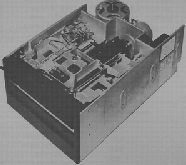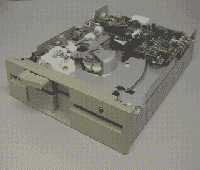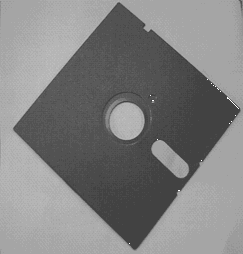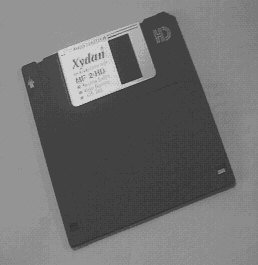|
The 8 inch floppy disk was born and it took several years for the UK to accept the spelling of DISK instead of DISC !
By 1980 the 8 inch drive was the industry standard. |
 |
||

|
With the quest for smaller devices to feed the home market the same technology was imbedded into a smaller 5,25 inch format.
This drive rapidly gained acceptance and by 1985 sales overtook the 8 inch units that were becoming rather cumbersome. | ||
| Here the floppy diameter is reduced to 5.25 inches and it could store 180 kbytes per side (a total of 360 kbytes). What helped to reduce the size was the development of the flat printed circuit stepper motor drive. As the data storage increased, 5.25 inch format was still too physically large and expensive to fuel the explosion in the PC market growth. With the development of the IBM PC AT came the 1.2Mb (high density) 5.25" floppy disk, this however was short lived and soon superseded by a smaller more robust development. |  |
||
 This development was the 3.5 inch floppy. This has been enormously successful and is still with us today as further improvements are made to data storage.
These drives appeared on the UK market in around 1988 and could store 720 kbyte. Being physically smaller and more robust (they could fit in a shirt pocket!), the actual magnetic floppy disk (called a "cookie" because it looked like one!) was enclosed in a rigid plastic sleeve (called a "clam-shell")
with a metal, slideable dust cover. Size reduction and hence also lower cost and higher reliability was achieved by further technical advances. During the last 5 years ASIC's (Application Specific Integrated Circuits)
have enabled the chip count to be dramatically reduced as more electronic circuitry is squeezed onto fewer chips. Also Surface Mount electronics have done away with the traditional pin-in-hole assembly and large chip casings which has enabled much faster, automatic
production techniques to be the norm hence reducing the cost of drives to the consumer. Disk drives were soon able to hold 1.44 Mbyte as further advances in the actual magnetic surfaces were developed. This size has become the standard for software distribution although 2.88Mb 3.5" drives are available. This development was the 3.5 inch floppy. This has been enormously successful and is still with us today as further improvements are made to data storage.
These drives appeared on the UK market in around 1988 and could store 720 kbyte. Being physically smaller and more robust (they could fit in a shirt pocket!), the actual magnetic floppy disk (called a "cookie" because it looked like one!) was enclosed in a rigid plastic sleeve (called a "clam-shell")
with a metal, slideable dust cover. Size reduction and hence also lower cost and higher reliability was achieved by further technical advances. During the last 5 years ASIC's (Application Specific Integrated Circuits)
have enabled the chip count to be dramatically reduced as more electronic circuitry is squeezed onto fewer chips. Also Surface Mount electronics have done away with the traditional pin-in-hole assembly and large chip casings which has enabled much faster, automatic
production techniques to be the norm hence reducing the cost of drives to the consumer. Disk drives were soon able to hold 1.44 Mbyte as further advances in the actual magnetic surfaces were developed. This size has become the standard for software distribution although 2.88Mb 3.5" drives are available.
|
|||
| Floppies are so convenient to store programs, send in the post and take home that they have remained popular - they are also very cheap. Today there are several other technologies competing for the number one slot. To increase the data storage further an optical track is manufactured in the cookie that enables much better head resolution and hence smaller tracks to be written. Again keeping up with the verbose, these are known as "flopticals" Floppy technology with Optical Alignment ). | |||
If this spiral was metaphorically unwound then the track length would be around 5 km ( 2,6 miles) !Today you can purchase Re-Write able CD's that make use of a change in phase of an optical layer where the aluminium was on the earlier devices. These are coming down in price both for the drives and the CD's themselves. So, on one end of the spectrum we have the popular, cheap floppy that ideally needs more disk space for hungry Window's applications and on the other end we have the CD ROM that has an established marked, but to move in on the floppy it would be ideally smaller and cheaper. | Now with the price of CD-R (writable CD-ROM) disks and drives plummeting rapidly it looks as though the CD format could eventually put the humble floppy disk to bed completely. The price of these drives however has yet to underprice the floppy drive. DVD (Digital Video Disk) is another new technology which is taking the market by storm. These disks/drives can hold far more than a standard CD-ROM, enough to hold an entire feature film with extra information about the script, actors etc. They also will be used in the gaming world where you can never have too much disk space!. With games now using 24-bit graphics and FMV (Full Motion Video) and running the processor and memory hungry Windows 95/98 operating systems the amount of storage space required is becoming enormous. We mustn't forget however that the PC is not the only platform which uses the humble floppy disk and there is still alot of equipment available which make use of them (e.g. musical keyboards & samplers). The very low cost and small size of the floppy disk, although quite short in the storage department will keep it alive for a while longer.... | ||